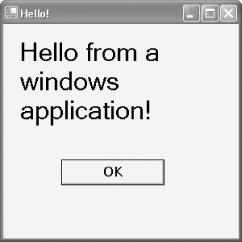

|
|
Chapter 2. Getting Started with C#You can use C# to create three different types of programs:
The .NET platform is web-centric. The C# language was developed to allow .NET programmers to create very large, powerful, high-quality web applications quickly and easily. The .NET technology for creating web applications is called ASP.NET. ASP.NET, the next generation from ASP (Active Server Pages), is composed of two Microsoft development technologies: Web Forms and Web Services. While the development of fully realized web applications using these technologies is beyond the scope of this book, learning the basics of the C# language will certainly get you started in the right direction. C# is generally acknowledged to be the language of choice for ASP.NET development. Typically, you'll create an ASP.NET application when you want your program to be available to end users on any platform (e.g., Windows, Mac, Unix). By serving your application over the Web, end users can access your program with any browser. When you want the richness and power of a native application running directly on the Windows platform, alternatively you might create a desktop-bound Windows application. The .NET tools for building Windows applications are called Windows Forms; a detailed analysis of this technology is also beyond the scope of this book. However, if you don't need a Graphical User Interface (GUI) and just want to write a simple application that talks to a console window (i.e., what we used to call a DOS box), you might consider creating a console application. This book makes extensive use of console applications to illustrate the basics of the C# language. Web, Windows, and console applications are described and illustrated in the following pages.
Figure 2-1. A console application Console applications are very helpful when learning a language because they strip away the distraction of the Graphical User Interface. Rather than spending your time creating complex windowing applications, you can focus on the details of the language constructs, such as how you create classes and methods, how you branch based on runtime conditions, and how you loop. All these topics will be covered in detail in coming chapters.
Figure 2-2. A Windows application
|

|
|